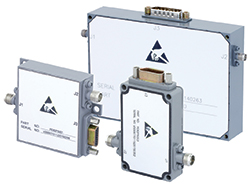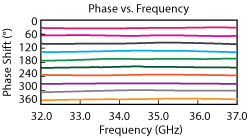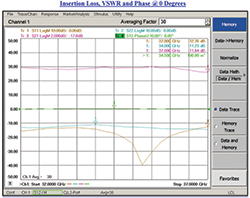
The latest military and industrial radar and microwave to millimeter wave backhaul applications require precise control of the input and output phase of their antenna arrays over a wide range of frequencies. These applications benefit from high performance antenna arrays that reduce size, weight, power and cost (SWAP-C) over prior technologies, while increasing effective range and sensitivity. Without this technology, the latest electronic warfare (EW) active electronically scanned arrays (AESA) employed for mission critical jamming operations on modern fighters would not be possible. A pivotal device enabling these systems is the digital phase shifter, used to ensure the precise control and beam forming of the antenna array.
To serve the demands of this market, Pasternack is now offering highly accurate 8-bit digital phase shifters with broadband frequency ranges starting at 500 MHz and extending to 37 GHz. Four models are currently available, each offering a full 360° phase shift range with 1.41° phase resolution. Key to Pasternack’s offering is in-stock, same-day shipping available for all RF products, critical when a long lead time could delay impending project deadlines and increase costs.
Pasternack’s four models offer extremely flat phase over 0.5 to 2 GHz (PE82P5000), 8.5 to 11 GHz (PE82P5001), 6 to 18 GHz (PE82P5002) and 32 to 37 GHz (PE82P5003). The 256-step, 360° phase range enables precise digital control with an 8-bit TTL logic input. Figure 1 shows the performance of the millimeter wave model. The control voltage range is 0 to 10 V DC and interfaces with an industry standard 15-pin Micro-D connector, which enables easy system integration and ensures a robust physical design. Switching speeds as low as 30 to 500 ns also ensures rapid response and agile beam forming from an antenna array.

Figure 1 The PE82P5003 digital phase shifter provides flat phase shift over 32 to 37 GHz, ensuring accurate operation of broadband antenna array systems.
Along with flat phase response over frequency, these phase shifters achieve low insertion loss with low variation typical throughout the operating range. Low insertion loss in a phase shifter benefits an antenna array application by decreasing the demand on the power amplifiers that drive the array. This can lead to greater linearity, reduced SWAP-C, lower noise and greater sensitivity. Additionally, the highly integrated hybrid MMIC design architecture provides noise and linearity benefits. The architecture offers enhanced noise immunity from the control lines and greater unit-to-unit performance consistency. The architecture responds with little delay to the digital control logic, enabling faster switching speeds. As a flatter phase response over the broadband frequency range and high power handling enable improved linearity performance, these phase shifters add less of a burden on other components in the system. For example, when embedded in a system with imperfectly impedance-matched components, this phase shifter architecture will demonstrate less susceptibility to phase pulling.
Rugged enough for many EW, military communications and test and measurement applications, Pasternack’s phase shifters have durable packages with field-replaceable coaxial connectors: SMA female for all but the PE82P5003, which employs 2.92 mm female connectors for better millimeter wave performance. The phase shifters operate from –55° to +85°C and meet or surpass many MIL-STD-202F environmental specifications for humidity, shock, vibration, altitude and temperature cycling. The hybrid MMIC design also enables a small footprint and thin package, ideal for compact systems with many elements.
All phase shifters in this series operate with ±15 DC bias. The four digital phase shifters have a maximum CW input power of 3 (PE82P5000), 13 (PE82P5001), 20 (PE82P5002) and 10 dBm (PE82P5003). Typical insertion loss is 8.5, 10, 10 and 13 dB, respectively. Amplitude errors are low: ±1, ±1, ±2.5 and ±1.5 dB.

Figure 2 Insertion loss and VSWR at the 0° phase state of the PE82P5003 digital phase shifter.
The PE82P5000 employs a digital-to-analog (D/A) converter and an analog phase shifter to offer a digitally-controlled analog phase shifter with 8-bit accuracy and 256 discrete values. Over the 0.5 to 2 GHz frequency range, the device has a low amplitude error of ±1 dB and maximum phase shift error of ±10°. Insertion loss is a maximum of 13 dB and input power handling is1 W CW maximum.
The PE82P5001 demonstrates a low switching speed of 100 ns within its 8.5 to 11 GHz frequency range. Input and output VSWR is typically 1.8:1, with a passband phase accuracy of ±9 dB and a phase error less than ±2°. Additionally, the spurious content of this device is better than –130 dBm without input or control updates.
The PE82P5002 covers 6 to 18 GHz with a maximum input VSWR of 2:1. When employed as a frequency translator, this phase shifter typically has a translation rate of 500 kHz, carrier suppression of 18 dB and sideband suppression of 15 dB. A low harmonic distortion of –25 dBc demonstrates the high linearity over the 12 GHz of bandwidth.
The PE82P5003 operates in the millimeter wave band from 32 to 37 GHz, with typical insertion loss of 13 dB across the passband (see Figure 2). For the highest performance, a 2.92 mm female connector is used for the input and output ports, which generally achieves an input VSWR of 2:1 and output VSWR of 2.5:1. This device typically has a phase resolution of 1.41° and low phase error of ±5°, with a switching speed of 500 ns maximum.
Pasternack
Irvine, Calif.
+1 866-PASTERNACK
www.pasternack.com
